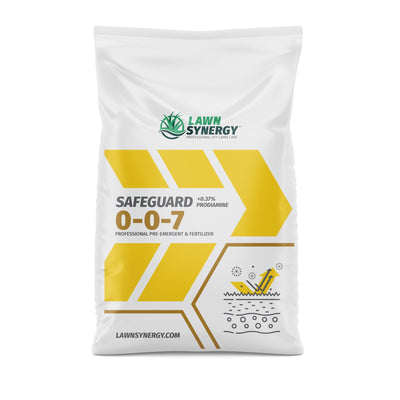Weeds pop up like clockwork in North Texas, unless your lawn strikes first.
Thanks to unpredictable weather and a wide range of invasive species, homeowners often feel like they're constantly battling weeds.
If you're looking for a long-term solution, finding the best pre-emergent for North Texas is key.
This guide explains how pre-emergents work, when and how to apply them, and which products are most effective, especially for DIYers who want results that rival professional services.
What this article covers:
- Understanding Pre-Emergent Herbicides
- Best Pre-Emergent Products for North Texas
- Soil and Lawn Type Considerations
- Matching Pre-Emergents to Your Grass Type
- Maintaining a Weed-Free Lawn Year-Round
Understanding Pre-Emergent Herbicides
What Are Pre-Emergents and How Do They Work?
Pre-emergent herbicides are designed to stop weeds before they sprout. They form a chemical barrier in the soil that disrupts seed germination, targeting annual weeds like crabgrass and poa annua.
What Pre-Emergents Can and Can't Do
While powerful, pre-emergents aren't miracle solutions. They won't kill existing weeds or prevent every single weed. Think of them as your first line of defense, not your entire arsenal.
Pre-Emergents vs. Weed and Feed
Pre-emergents are proactive. Weed and Feed for lawns combine fertilizer and post-emergent herbicide, but often lack the specificity and strength of a dedicated pre-emergent.
Use pre-emergents early; save Weed and Feed for spot treatment.
Best Pre-Emergent Products for North Texas
With timing and technique in place, choosing the right product is the final piece of the puzzle. We trust these professional-grade pre-emergents for DIY success across North Texas lawns.
Each one is designed to stop weeds before they sprout, while giving your lawn exactly what it needs to thrive.

Guardian 13-0-10 Pre-Emergent Fertilizer
The Guardian Pre-emergent 13-0-10 Fertilizer solution combines Prodiamine (0.29%) with a balanced 13-0-10 NPK fertilizer, making it great for homeowners who want weed prevention and lawn nutrition in one step.
It should be applied at 5lbs per 1,000 sq. ft., ideal for most residential lawns. It's especially effective against crabgrass and other common annual weeds.
The added potassium promotes turf resilience, while slow-release nitrogen fuels steady growth.
- Pros: Dual-action performance, supports healthy turf, and professional-grade results.
- Considerations: Not ideal for lawns that are still dormant..
Safeguard 0-0-7 Pre-Emergent Fertilizer
For lawns that already have a fertilization schedule in place, or that are still dormant, the Safeguard 0-0-7 Pre-emergent Fertilizer offers focused weed prevention with Prodiamine (0.37%) and zero added nitrogen.
Applied at 5lbs. Per 1,000 sq. ft., this higher concentration of Prodiamine means stronger and longer-lasting control against weed seeds without influencing grass growth.
- Pros: High efficacy, no nitrogen interference, easy to apply.
- Considerations: Doesn't provide additional nutrients, so a separate fertilizer may be necessary.
Specticle G Pre-Emergent Herbicide
Powered by Indaziflam, Specticle G Pre-Emergent Herbicide delivers industry-leading pre-emergent performance with up to 6 months of weed control.
It's only for warm-season grasses and is used on high-end properties for its broad-spectrum effectiveness. Although coverage varies depending on rate and application area, this product excels at targeting both grassy and broadleaf weeds.
- Pros: Long-lasting control, wide weed spectrum, professional-grade performance.
- Consideration: Higher price point, not suitable for cool season grass types.

When to Apply Pre-Emergents in North Texas
Timing is everything when it comes to effective weed prevention, especially in a region like North Texas, where unpredictable weather and soil diversity can either help or hinder your efforts.
Getting the application window right ensures your pre-emergent herbicide forms that crucial barrier before weeds have a chance to sprout. Here's how to nail the timing like a pro.
Seasonal Timing for Success
These windows are based on the typical weed germination cycles in Texas.
Miss the mark, and your pre-emergent might not do much at all.
- Spring: Apply between early January and again in March. This targets aggressive warm-season weeds like crabgrass and goosegrass before they emerge.
- Fall: Apply from early September to mid-October to prevent cool-season nuisances like annual bluegrass (Poa annua) and henbit.
Why Soil Temperature Beats the Calendar
Soil temperature is a great guide, often beating the calendar. For best pre-emergent results in North Texas, the magic range in spring is before soil temperatures reach 55°F. If fall, pre-emergent needs to be applied before soil temperatures drop down to 70°F at a 2" depth.
That's when seeds are just starting to stir, and that's your cue to act.
- Use free tools like GreenCast or Soil Temperature Maps to monitor real-time readings in your zip code.
- Consider a simple soil thermometer if you prefer hands-on data.
This proactive step ensures your product reaches the soil at peak effectiveness, forming a chemical barrier right before germination, not after.
Weather Forecasting Tips
Weather is another make-or-break factor. While water is needed to activate most pre-emergents, too much rain can dilute or wash them away. Follow these guidelines:
- Avoid application before heavy rainstorms.
- Aim to apply when light to moderate irrigation or rainfall (0.25"–0.5") is expected within 24–48 hours.
- Do not apply to saturated ground or just before mowing.
- Remember, if pre-emergents do not get watered in, they will not work.
Taking a moment to check the forecast can make the difference between a weed-free season and a frustrating do-over.

Soil and Lawn Type Considerations
Whether you're aiming for the best pre-emergent for Poa annua or simply trying to keep broadleaf weeds at bay, the soil you're working with plays a huge role in effectiveness.
Clay Soils
Heavy clay soils (common throughout Dallas-Fort Worth) retain moisture and chemicals longer, which means pre-emergents tend to last a bit longer here.
However, compaction is a real issue. If your lawn feels like concrete underfoot or pools water during rain, it's a sign you need to aerate before applying the product to ensure it penetrates effectively.
Homeowners in clay-rich areas often benefit from longer-lasting formulations, especially if they're targeting persistent weeds like Poa annua.
Sandy Loam Soils
Found more often in areas like Denton or the outskirts of Fort Worth, these soils drain quickly, which is great for turf roots but can reduce herbicide longevity.
In sandy loam, you may need to re-apply closer to the 8-week mark, especially in warmer months when breakdown happens faster.
This is particularly true when selecting the best pre-emergent for Arizona, where similar soil conditions and climate call for reapplication vigilance.
Matching Pre-Emergents to Your Grass Type
Each grass species has unique sensitivities and growth patterns. Matching your herbicide to your turf type is key to avoiding damage while maximizing effectiveness.
Bermuda Grass
The most common lawn type in Texas, Bermuda, thrives in sun but grows aggressively. You'll want a fast-acting pre-emergent applied early in the season to stay ahead of warm-season invaders.
The best pre-emergent for Bermuda grass in Texas will typically feature prodiamine or dithiopyr as the active ingredient. Both are proven to stop weeds like crabgrass and goosegrass before they take over.

St. Augustine
This broad-bladed, shade-tolerant turf is more sensitive to chemical stress.
Look for pre-emergents explicitly labeled safe for St. Augustine and avoid overapplication. Timing is critical—too early, and you risk root suppression; too late, and weeds win.
Lawn Synergy's granular pre-emergent options are often the safest bet for this finicky species.
Zoysia Grass
Slow-growing and dense, Zoysia responds best to dithiopyr-based pre-emergents.
These are considered the best pre-emergent for zoysia because they offer strong residual control while minimizing stress on this thick-bladed grass.
For maximum effectiveness, apply when soil temperatures are just reaching the 60°F threshold.
Maintaining a Weed-Free Lawn Year-Round
A truly weed-free lawn isn't achieved with a one-time application—it results from a consistent, season-long strategy.
Pre-emergents are a powerful tool, but their effectiveness multiplies when combined with a holistic lawn care program tailored to your turf's unique needs.
Fertilization: Fuel Growth, Crowd Out Weeds
Healthy, thick turf is your lawn's best natural defense. When grass is thriving, there's no room for weeds to take hold.
That's why pairing your pre-emergent with Lawn Synergy's pro-grade fertilizers like Emerald 10-0-20 (ideal for stress resistance and color) and Almighty 20-0-10 (designed for aggressive growth and recovery) is so revolutionary.
These blends are enhanced with extra nutrients and used on high-end properties. They are now available in homeowner-sized bags with DIY guidance included.
This approach is just as essential in dry, challenging climates like Arizona, where pairing weed control with nourishment ensures long-term success.
For that reason, many of our products are also rated the best pre-emergent for Arizona lawns.

Irrigation: Consistency Over Volume
Weeds thrive in both extremes—drought-stressed lawns and oversaturated soil.
Instead of watering too often or too little, aim for consistent, deep watering about once or twice a week, depending on rainfall and soil type. If the weather is producing enough water, you don’t need to water more.
In clay-heavy areas of North Texas, slow soaking helps prevent runoff. For sandy loam, consider shorter, more frequent watering to retain moisture without leaching nutrients.
Mowing: The Right Height at the Right Time
Each grass type has a mowing sweet spot:
- Bermuda: 1–1.5 inches
- St. Augustine: 2.5–4 inches
- Zoysia: 1.5–2.5 inches
Sticking to the proper height helps shade out weed seeds and encourages horizontal growth, which thickens your turf.
Conclusion
The path to a lush, weed-free lawn in North Texas starts with timing, the right product, and proper application.
By choosing the best pre-emergent for North Texas and pairing it with Lawn Synergy's professional-grade support, DIY homeowners can finally ditch the generic approach. Instead, go pro at home
Explore our curated pre-emergent products or get expert advice tailored to your lawn today.
Lawn Synergy is here to help you make your lawn perfect—together.
If you want to learn more, check out these articles below:
- What Is a Pre Emergent?
- How Do Pre Emergent Herbicides Work?
- Pre Emergent Herbicide List
- Pre Emergent vs Post Emergent
- What Is Pre Emergent for Lawns?
- Best Pre Emergent
- Best Pre Emergent for Lawns
- Best Pre Emergent for Bermuda
- Best Pre Emergent for St Augustine
- Best Pre Emergent for Centipede Grass
- How Long Does Pre Emergent Last?
- Is It Too Late for Pre Emergent?
- Does Pre Emergent Work?
- Can I Put Pre Emergent on Wet Grass?
- How Long Does Barricase Pre Emergent Last?


